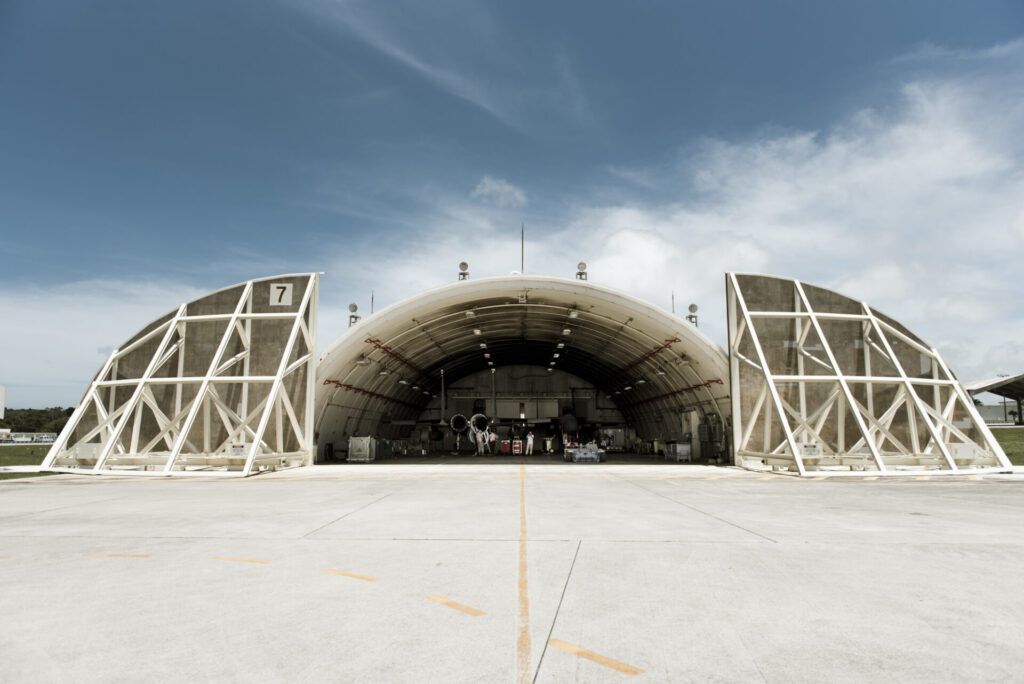By sending nuclear weapons to the United Kingdom, could the United States be fueling nuclear proliferation?
By Janani Mohan | April 10, 2024
 The Royal Air Force Lakenheath base in the United Kingdom currently operates the F-15E Eagle and the latest generation F-35A Lighting II fighter aircraft, which can both carry nuclear bombs. In January 2024, The Telegraph disclosed US plans to store nuclear weapons at Lakenheath for the first time in 15 years. Nuclear weapons are stored in underground vaults located inside aircraft shelters similar to this one at Kadena Air Base, Japan. In the 1990s, there were 33 underground storage vaults at Lakenheath. (Credit: US Air Force / Omari Bernard, via DVIDS)
The Royal Air Force Lakenheath base in the United Kingdom currently operates the F-15E Eagle and the latest generation F-35A Lighting II fighter aircraft, which can both carry nuclear bombs. In January 2024, The Telegraph disclosed US plans to store nuclear weapons at Lakenheath for the first time in 15 years. Nuclear weapons are stored in underground vaults located inside aircraft shelters similar to this one at Kadena Air Base, Japan. In the 1990s, there were 33 underground storage vaults at Lakenheath. (Credit: US Air Force / Omari Bernard, via DVIDS)
For the first time in 15 years, the United States is reportedly planning to station nuclear weapons in the United Kingdom, a decision many experts interpret as attempting to counter growing geopolitical instability. As the war in Ukraine rages on, nuclear posturing—including stationing nuclear weapons in other countries—is seen by nuclear powers as an important tool to prevent further escalation, reassure allies, and respond to changes in Russia’s posturing.
The stationing of nuclear weapons is a convenient loophole to the safeguards of the Nuclear Non-Proliferation Treaty (NPT). While certain countries under the NPT are non-nuclear weapons states and cannot develop their own nuclear weapons programs, they can host weapons stationed by nuclear weapons states. Traditionally, nuclear powers have managed the entire control of their weapons—for example, by locating the nuclear weapons on joint bases.
However, while this control exists as a safeguard, stationing nuclear weapons as a means of posturing raises the question of what the difference is between “stationing” and “proliferating.” If near-term security concerns are well-served by the recent US decision to move nuclear weapons in the United Kingdom, it could augment the US practice of stationing nuclear weapons in other countries—a practice with potentially harmful consequences for long-term nonproliferation goals.
Why the United Kingdom. As the closest US ally, the United Kingdom serves as an interesting location for this latest round of nuclear posturing, given that it already has its own nuclear arsenal.
Historically, the United States and United Kingdom have worked together closely on the development of nuclear weapons, starting with collaborations on the Manhattan Project. Since the 1960s, the United States started deploying nuclear weapons to the United Kingdom at regular intervals. This practice carried on until 2008, when the United States removed approximately 110 B-61 nuclear bombs from the Royal Air Force base at Lakenheath—the same base believed to soon receive US nuclear weapons again. At the time the United States kept this withdrawal quiet, but some experts believed that it was intended to reduce and consolidate US nuclear forces in Europe.
Like with the secrecy in 2008, the United States has once again not formally commented on its recent shift in posture to re-station nuclear weapons in the United Kingdom. As a spokesperson for the UK Ministry of Defence said of the US decision, “it remains a longstanding UK and NATO policy to neither confirm nor deny the presence of nuclear weapons at a given location.”
Why station nuclear weapons? While the reasons behind this recent US decision are uncertain, stationing nuclear weapons in the United Kingdom potentially serves several US national interests.
The first and foremost reason may be to respond to growing tensions with Russia. NATO countries are very concerned about the Russian aggression and recently warned that there was a high likelihood for full-scale war with Russia within the next two decades. In addition, the United States did not make the first move: Russia stationed nuclear weapons in Belarus and revoked its ratification of the Comprehensive Nuclear Test Ban Treaty last year. The stationing of US nuclear weapons in the United Kingdom in response appears therefore somewhat predictable, given the general Cold War mentality of responding in-kind to shifts in doctrine.
The decision to station nuclear weapons therefore postures the United States as paying attention to Russia’s recent escalations and signals its willingness to respond in the future with nuclear weapons, if necessary. This decision reinforces the US nuclear deterrence policy, which states that: “As long as nuclear weapons exist, the fundamental role of US nuclear weapons is to deter nuclear attack on the United States, our allies, and partners.”
The US decision can also be interpreted as aiming to complement—and therefore strengthen—the UK nuclear weapons arsenal. Currently, the United Kingdom has the smallest inventory of any of the NPT’s nuclear weapons states, and these warheads are all based at sea. Meanwhile, the nuclear weapons that the United States will likely station in the United Kingdom are B61-12 gravity bombs, which are deployable by aircraft. This deployment would enable forces in the region to have further and distinct second-strike capabilities, while adding to the overall strength of NATO forces across Europe.
Finally, the US decision is one of the safest, when compared to other posturing options. It is no doubt safer to place nuclear weapons in countries already possessing nuclear weapons, like the United Kingdom, than in those that don’t, like Turkey. Nuclear weapons states are lower risk as they would have minimal interest in proliferating these weapons. In addition, the United Kingdom already has sophisticated security systems and safeguards that would reduce both security risks and costs for the United States.
So why worry? The stationing of US nuclear weapons in the United Kingdom is unlikely to increase the physical risk of proliferation: Malicious actors are not more likely to gain access to nuclear weapons given the UK security apparatus. However, there are potential risks to the framework of nonproliferation itself. By re-stationing nuclear weapons in the United Kingdom, the United States is conveying that it is concerned over current nuclear tensions and that it might need to respond with nuclear weapons if attacked, which could increase future incentives for proliferation.
Stationing nuclear weapons in non-nuclear weapons states has always been an interesting gap in the nuclear nonproliferation frameworks of the NPT. However, regardless of the differences between “stationing” and “proliferating” nuclear weapons, the overall expansion of nuclear weapons still risks a cycle of escalation. Actions like the recent US decision may reduce taboos on the expansive stationing of nuclear weapons, thereby providing incentives for proliferation as a solution to counter increased aggression by countries, like Russia’s invasion of Ukraine.
For example, some Ukrainian policymakers have already unofficially suggested that Ukraine should “restore [its] nuclear status”—which means developing its own nuclear weapons—to deter Russia. Although such statements are intended to convince the United States and NATO to provide Ukraine with some form of nuclear guarantees, they also suggest that an increasing need for nuclear deterrence inherently comes with increased risk of nuclear proliferation.
The risk of escalation may explain the current US and NATO strategy of stationing nuclear weapons semi-secretively. The United States ensures that its adversaries know that it is stationing nuclear weapons in ally countries like the United Kingdom, but adversaries are left with uncertainties about where those forces exactly are as the United States never formally discusses this posture. This strategy not only increases US deterrence, it may also reduce some of the escalatory impact of explicitly re-positioning nuclear weapons, while still allowing the United States to respond to Russia.
Given proliferation concerns, such escalation-control practices are therefore important to maintain as the United States moves nuclear weapons to the United Kingdom, as well as other countries in the future. Although it is yet to be seen if the recent US decision has a meaningful impact on nonproliferation, nuclear powers must work to prevent nuclear weapons stationing from eroding norms surrounding nuclear nonproliferation.
Together, we make the world safer.
The Bulletin elevates expert voices above the noise. But as an independent nonprofit organization, our operations depend on the support of readers like you. Help us continue to deliver quality journalism that holds leaders accountable. Your support of our work at any level is important. In return, we promise our coverage will be understandable, influential, vigilant, solution-oriented, and fair-minded. Together we can make a difference.















As a US citizen, I believe my country ought to ratify The Comprehensive Nuclear-Test-Ban Treaty (CTBT). There’s no need to create more powerful weapons and there’s no need for anyone to invade anyone. We ALL have a world to save from mass species extinction. My two cents.